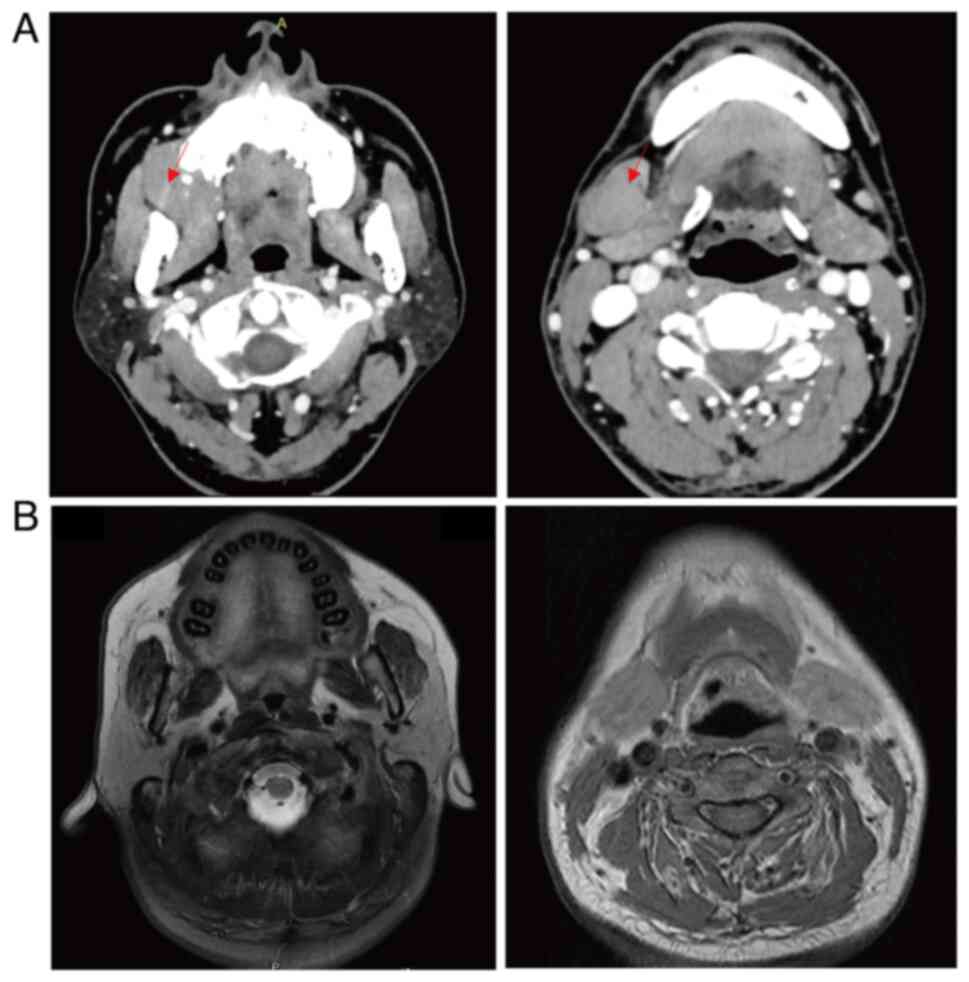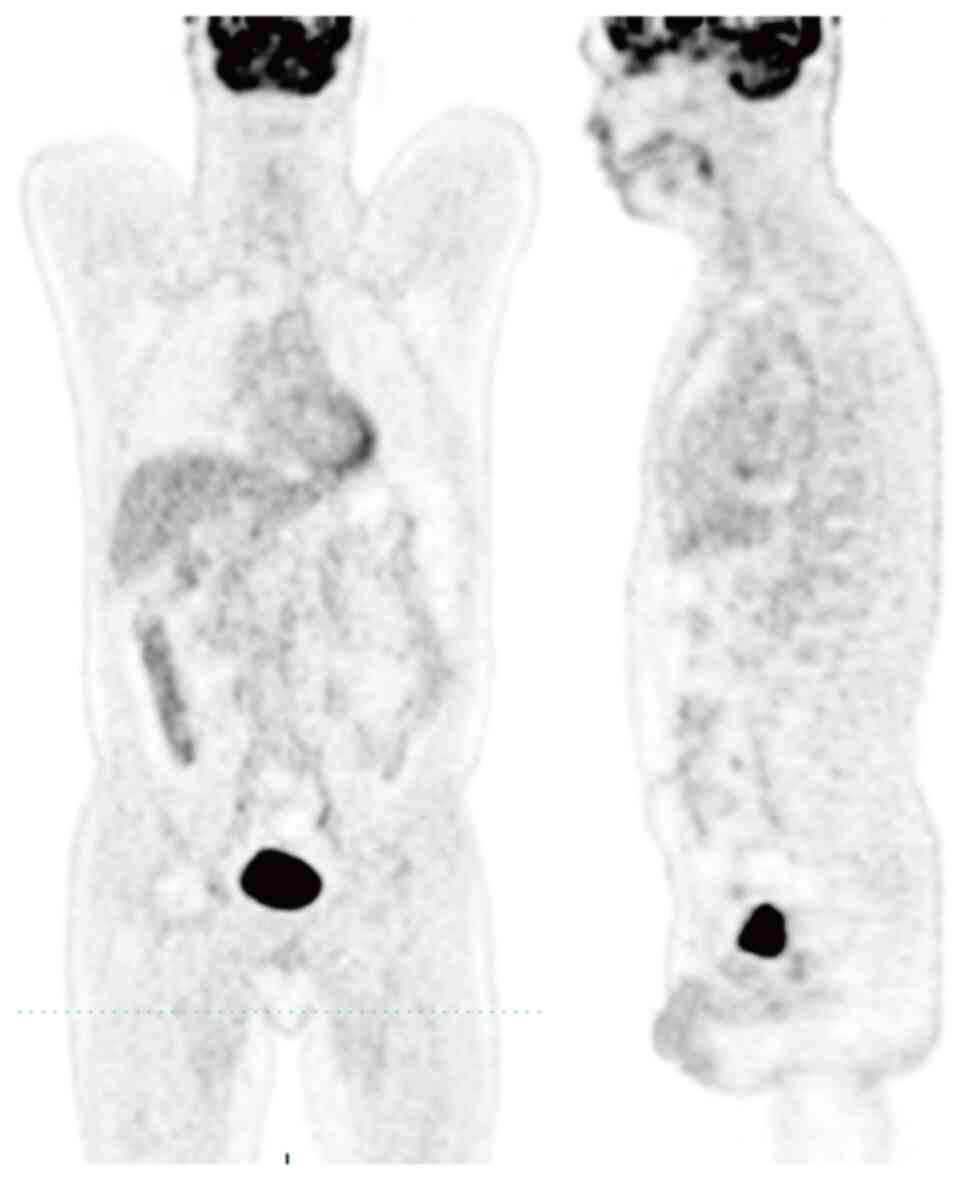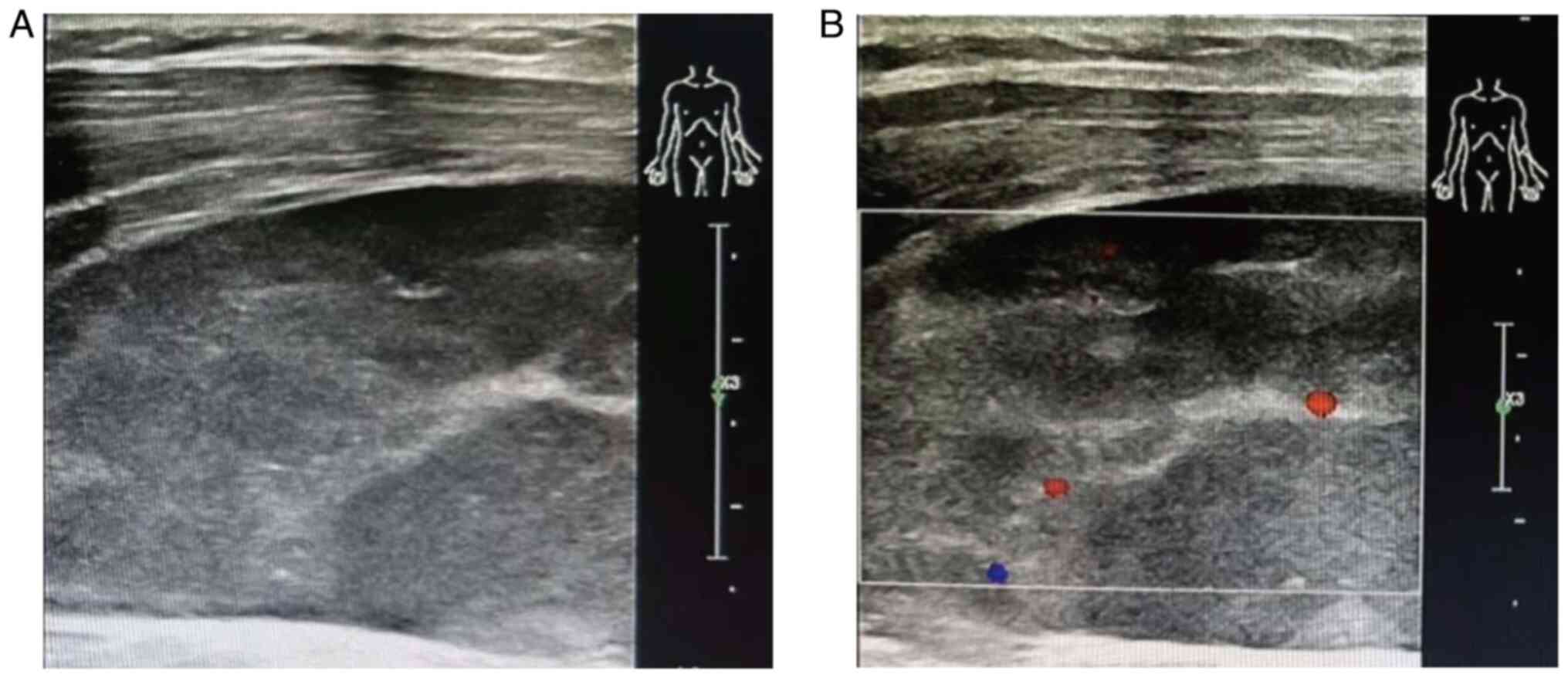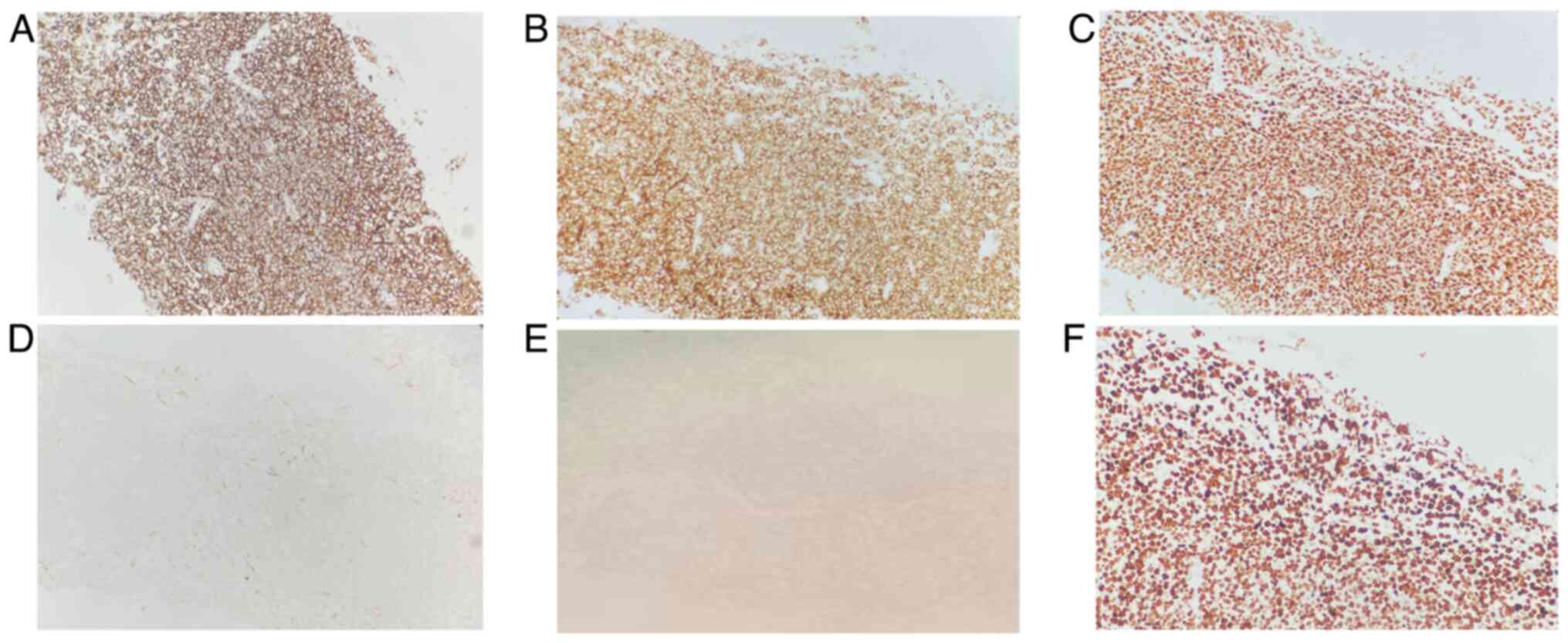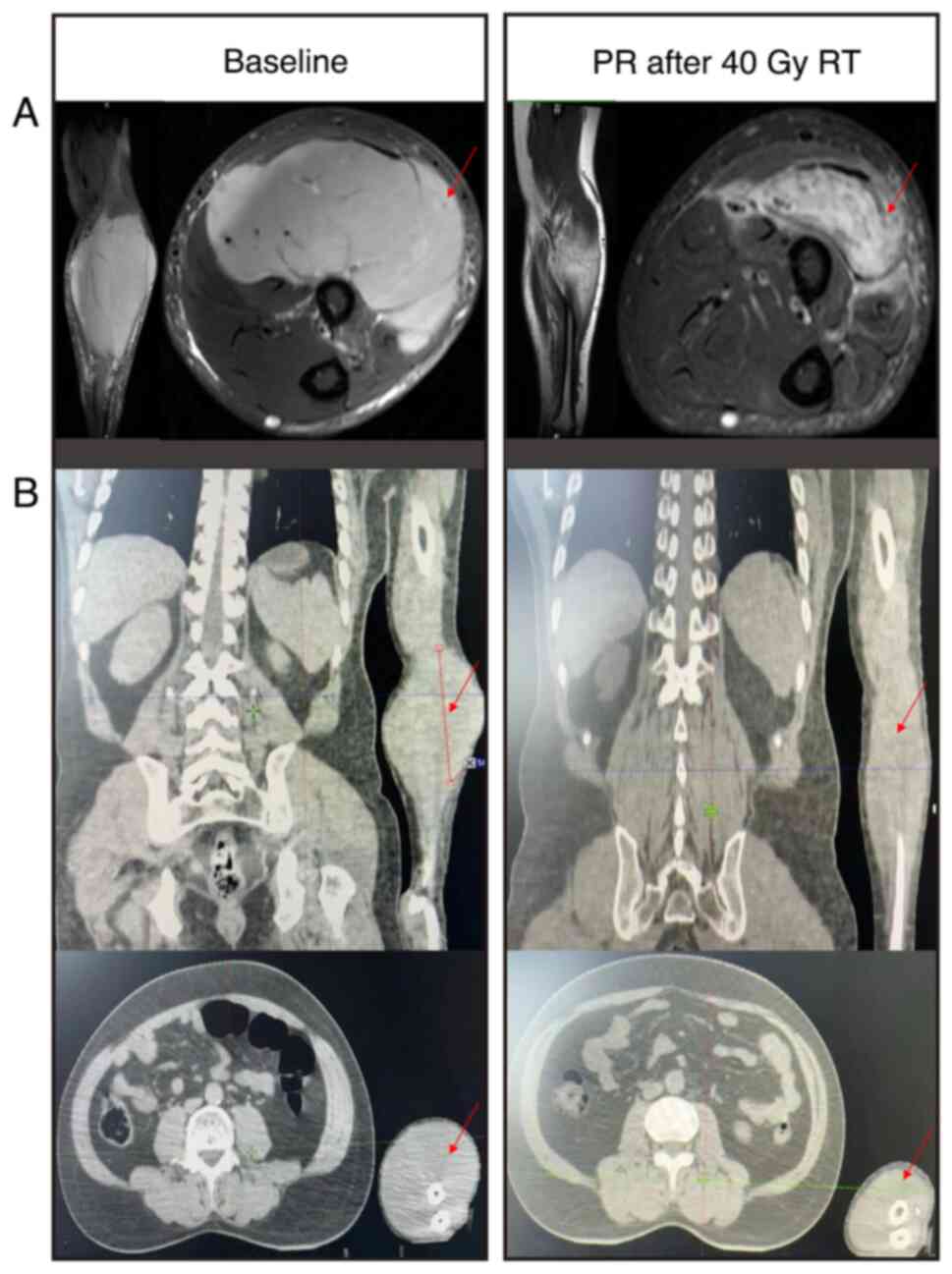Primary gingival diffuse large B‑cell lymphoma with muscle invasion: A case report
- Authors:
- Published online on: March 4, 2025 https://doi.org/10.3892/ol.2025.14958
- Article Number: 212
-
Copyright: © Deng et al. This is an open access article distributed under the terms of Creative Commons Attribution License.
Abstract
Introduction
Non-Hodgkin lymphoma (NHL) is the most prevalent form of malignant lymphoma and 40% of patients with NHL have diffuse large B-cell lymphoma (DLBCL) (1). DLBCL is an aggressive malignancy characterized by rapid progression and diverse clinical manifestations, depending on the site of origin and extent of disease dissemination (2). Gingival DLBCL is rare and occurs in ~1% of patients with primary extranodal lymphoma. Its rarity poses significant diagnostic and therapeutic challenges, as the initial clinical features often mimic benign conditions (3). Gingival DLBCL commonly manifests as a localized mass or ulcerative lesion in the oral mucosa, frequently accompanied by painless and progressive lymphadenopathy. These non-specific symptoms can lead to delayed diagnosis and disease progression. Most studies of gingival DLBCL have described histopathological and imaging features of this type of blood cancer; however, to the best of our knowledge, therapeutic strategies for gingival DLBCL with muscle invasion have not been described (4,5). The present study describes the clinical presentation, diagnostic approach, and therapeutic management of a patient with gingival DLBCL involving local muscle tissue. This case highlights the importance of a multidisciplinary approach, integrating oncology, maxillofacial surgery, and radiation therapy to achieve optimal outcomes. We aim to provide insights into the complexities of managing this rare but clinically significant presentation.
Case report
The physical examination of a 49-year-old man who initially presented at Yingshan County People's Hospital (Nanchong, China) in August 2017 revealed a firm mass in the lower left gingiva that measured ~3 cm, with tenderness and swelling. The Eastern Cooperative Oncology Group Performance Status score of the patient was 2 (3); and their blood test results were negative for the hepatitis B and C viruses, the human immunodeficiency virus (HIV) and the Epstein-Barr virus (EBV), although their lactate dehydrogenase (LDH) level was elevated (577 U/l; normal range: 120–250 U/l). The patient received a positron emission tomography computed tomography (PET-CT) scan, but these images became unavailable after an upgrade of the hospital's imaging system in 2019. The contrast-enhanced CT scans revealed the same findings as the PET-CT scans. Contrast-enhanced CT scans demonstrated a mass in the gingiva, and enlarged lymph nodes in the cervical, mediastinal and gastro-hepatic ligaments (Fig. 1). Bone marrow aspiration was performed and the specimens were subsequently analyzed using immunohistochemistry and a bone marrow smear, all of which demonstrated normal findings. The patient underwent gingival excision biopsy in August 2017, the diagnosis was established through immunohistochemical staining of the gingival biopsy specimen. The following markers were evaluated: CD20 (+), BCL-6 (+), BCL-2 (+), C-MYC (+), MUM1(+), NF-κB (+) and Ki-67 (+, 50–60%; data not shown). However, the patient declined next-generation sequencing (NGS) and fluorescence in situ hybridization (FISH) testing due to financial constraints, preventing determination of double-hit lymphoma (DHL) or triple-hit lymphoma (THL). These findings led to a diagnosis of DLBCL stage III (Ann Arbor staging system) (2) and an International Prognostic Index score of 4 (high risk) (3).
A total of six cycles of rituximab, cyclophosphamide, doxorubicin, vincristine and prednisone (R-CHOP, rituximab 600 mg + cyclophosphamide 800 mg + doxorubicin 110 mg + vincristine 2 mg + prednisone 500 mg) was administered as first-line chemotherapy. PET-CT showed no evidence of disease for 40 months (Fig. 2). A follow-up contrast-enhanced CT scan in December 2020 showed tumor progression with invasion of the left orbital region (data not shown). According to the National Comprehensive Cancer Network guidelines (2023, version 6) for relapsed/refractory (R/R) DLBCL, a regimen that is not cross-resistant to R-CHOP should be used, and autologous stem cell transplantation (ASCT) or CAR-T therapy should also be considered (6). However, due to the financial burden of ASCT or CAR-T, the patient did not undergo these treatments; therefore, the patient received four cycles of etoposide (400 mg), prednisone 500 mg, vincristine 2 mg, cyclophosphamide 1200 mg and doxorubicin 110 mg with rituximab 600 mg as second-line chemotherapy. The patient again achieved complete response until December 2021, when another contrast-enhanced CT scan detected retroperitoneal lymph node metastases (data not shown).
The patient then enrolled in a clinical trial at Sichuan Cancer Hospital (Chengdu, China): ‘A multicenter, single-arm, open phase I/II clinical trial to evaluate the safety and tolerability of SYHX1903 (a cyclin-dependent kinase-9 inhibitor) in patients with relapsed/refractory malignant lymphoma’ (trial no. CTR20212017). The patient achieved partial response after 1 month, but developed shortness of breath, tiredness and palpitations at 15 months after enrollment. Echocardiography at that time showed a massive pericardial effusion, and there was a large increase in the serum level of troponin (7.8 ng/ml; normal range, 0–0.1 ng/ml; data not shown). The patient was diagnosed with heart failure (New York Heart Association Class III) (6), and the cardiologist considered the high doses of doxorubicin and the study drug (SYHX1903) as potential causes. Thus, the patient withdrew from the clinical trial and regular follow-up was conducted.
In January 2024, the patient injured their left forearm in a car accident and presented with limb swelling. Examination by color Doppler imaging (CDI) revealed a hypoechoic mass with a clear boundary and regular shape that was ~8.0×3.0 cm. Color Doppler flow imaging showed a spot blood flow signal around the mass and the suggested diagnosis was ‘hematoma considered’ (Fig. 3). The results from subsequent magnetic resonance imaging (MRI) demonstrated a signal with intermediate intensity on the T1-weighted images and a signal with slightly higher intensity than the normal surrounding muscle on T2-weighted images. These results demonstrated a spindle-shaped mass in the brachioradialis and supinator that was ~4.5×9.6 cm. Contrast-enhanced CT of the chest and abdomen indicated no evidence of abnormality (data not shown). These results led to prompt administration of a CT-guided biopsy of the forearm muscle. The results of immunohistochemical staining were CD20 (+), CD79a (+), BCL-2 (−), C-MYC (−), CD10 (−), BCL-6 (−), MUM1 (+) and Ki-67 (+, 90%) (Fig. 4). These results confirmed a diagnosis of muscle invasion by gingival DLBCL. After a multidisciplinary consultation, local radiotherapy (RT) was administered, due to the patient suffering from heart failure during the third line of the previous chemotherapy. The RT dose was 40 Gy in 20 fractions and led to partial response after 4 weeks (Fig. 5). The irradiated field was then decreased and an additional dose of 10 Gy was administered in 5 fractions. The last RT dose was in April 2024, and at the most recent follow-up (August 2024) the patient had a good quality-of-life and a survival time beyond 84 months.
Discussion
In most patients with extranodal NHL the digestive system is affected, and this type of cancer is rare in the gingiva (7). Notably, there is a paucity of data regarding primary gingival DLBCL in patients who are HIV-negative (3), although most patients who present with gingival DLBCL have tumors in the maxilla (8,9). A review of the literature identified 22 other cases of primary gingival DLBCL in HIV-negative patients between 2008 and 2024 (Table I). The median age of the patients was 63.2 years (range, 31–87 years), and most of these patients had normal LDH levels, stage I–II cancer, received R-CHOP or RT, and had a favorable prognosis. Notably, it is possible that immune dysregulation may be involved in primary gingival DLBCL. For example, Shapiro (10) reported on the case of an 81-year-old patient with gingival DLBCL who was EBV-positive and was taking methotrexate for 50 years as treatment for psoriasis; this patient experienced tumor remission after discontinuing methotrexate. By contrast, in the present case report, the patient was EBV-negative, they did not use any immunosuppressive agent, and the initial R-CHOP regimen had a long-term and stable curative effect.
DHL and THL are highly aggressive variants of B-cell lymphoma that are characterized by simultaneous rearrangements of MYC and one or more additional oncogenes, such as BCL2 or BCL6 (11). Relative to other lymphoma subtypes, these genetic abnormalities contribute to a more unfavorable prognosis due to increased tumor cell proliferation, greater resistance to treatment and a higher likelihood of relapse (12). These more aggressive types of lymphoma often necessitate more intensive therapeutic approaches and are associated with significantly lower survival rates (13). Identifying these genetic mutations is critical for achieving precise prognostication and tailoring individualized treatment regimens, because DHL and THL tend to be more treatment-resistant and associated with less favorable responses to standard therapies (14). However, in the present case, the patient was unable to bear the financial burden and thus refused further NGS and FISH testing. However, based on the aggressive disease progression, this patient may have had DHL or THL.
A rare feature of the present patient was invasion of the gingival DLBCL to muscle in the forearm. Notably, two possible mechanisms could be suggested for this: i) Disease dissemination via a hematogenous or lymphatic pathway, or ii) disease extension from adjacent organs, such as the bones or lymph nodes (15). The most frequently encountered clinical symptoms in patients with gingival DLBCL are painful swelling and local edema. Muscle lymphoma has certain distinctive characteristics on MRI that allow it to be distinguished from other soft-tissue tumors (16). In particular, the signal intensity of a T1-weighted image has a similar or slightly increased signal intensity compared with normal muscle, and the T2-weighted signal has a high intensity relative to normal fat tissue (17,18). The MRI of the present patient clearly demonstrated these features. The identification of tumor recurrence in the forearm was fortuitous and only occurred because the patient required imaging following a car accident. The CDI results of lymphoma in skeletal muscle are nonspecific and often make it difficult to distinguish lymphoma from hematoma, sarcoma, metastases or myositis (19). This emphasizes the need for a biopsy and pathological evaluation for the diagnosis of skeletal lymphoma. The immunohistochemical staining results of the forearm muscle: CD10 (−), BCL-6 (−) and MUM1 (+), led to the diagnosis of non-germinal center B-cell (non-GCB) type DLBCL, and suggested a poor prognosis (20).
Previous studies have reported that R-CHOP can significantly decrease disease relapse and progression in patients with non-GCB type DLBCL (21,22). For example, Nyman et al (23) reported that the R-CHOP regimen eliminated differences in prognosis for patients with immunohistochemically defined GCB and non-GCB phenotypes of DLCBL. However, in the present case, the patient suffered from severe cardiac problems following a previous chemotherapy regimen and was therefore administered palliative RT to relieve symptoms and delay local disease progression. The guidelines of the International Lymphoma Radiation Oncology Group suggest the use of RT for R/R aggressive DLBCL, with salvage doses up to 55 Gy (24). Wong et al (25) described 217 patients with R/R DLBCL who altogether received 370 courses of palliative RT. The median equivalent dose was 19 Gy (range, 2–42 Gy) and the rate of local control at 6 months was 66.7%. In the present case, 40 Gy in 20 fractions was initially administered, and the patient achieved a partial response. To minimize radiation damage, the irradiated field was then reduced and an additional dose of 10 Gy in 5 fractions was administered.
In conclusion, invasion of gingival DLBCL to the muscle is rare, and the diagnosis requires consideration of medical history and a combination of procedures, including imaging and histological examination. Individualized treatment of these patients is necessary, although determination of the most appropriate treatment regimen can be challenging.
Acknowledgements
Not applicable.
Funding
Funding: No funding was received.
Availability of data and materials
The data generated in the present study may be requested from the corresponding author.
Authors' contributions
WX, XD and YL conceived and designed the study. WP and JZ collected the data. QY and BC analyzed and interpretated the results. WX and XD wrote the manuscript. WG and YL confirm the authenticity of all the raw data. All authors have read and approved the final version of the manuscript.
Ethical approval and consent to participate
The patient provided written informed consent for the publication of this case report.
Patient consent for publication
Written informed consent was obtained from the patient for the publication of this case report and any accompanying images.
Competing interests
The authors declare that they have no competing interests.
References
|
Li S, Young KH and Medeiros LJ: Diffuse large B-cell lymphoma. Pathology. 50:74–87. 2018. View Article : Google Scholar : PubMed/NCBI | |
|
Michi Y, Harada H, Oikawa Y, Okuyama K, Kugimoto T, Kuroshima T, Hirai H, Mochizuki Y, Shimamoto H, Tomioka H, et al: Clinical manifestations of diffuse large B-cell lymphoma that exhibits initial symptoms in the maxilla and mandible: A single-center retrospective study. BMC Oral Health. 22:202022. View Article : Google Scholar : PubMed/NCBI | |
|
Sugimoto KJ, Shimada A, Sakurai H, Wakabayashi M, Imai H, Sekiguchi Y, Nakamura N, Sawada T, Izumi H, Ota Y, Komatsu N and Noguchi M: Primary gingival diffuse large B-cell lymphoma: A case report and a review of the literature. Int J Clin Exp Pathol. 7:418–424. 2013.PubMed/NCBI | |
|
Bhattacharyya I, Chehal HK, Cohen DM and Al-Quran SZ: Primary diffuse large B-cell lymphoma of the oral cavity: Germinal center classification. Head Neck Pathol. 4:181–191. 2010. View Article : Google Scholar : PubMed/NCBI | |
|
Silva TD, Ferreira CB, Leite GB, de Menezes Pontes JR and Antunes HS: Oral manifestations of lymphoma: A systematic review. Ecancermedicalscience. 10:6652016. View Article : Google Scholar : PubMed/NCBI | |
|
Zelenetz AD, Gordon LI, Abramson JS, Advani RH, Andreadis B, Bartlett NL, Budde LE, Caimi PF, Chang JE, Christian B, et al: NCCN Guidelines® Insights: B-Cell Lymphomas, Version 6.2023. J Natl Compr Canc Netw. 21:1118–1131. 2023. View Article : Google Scholar : PubMed/NCBI | |
|
Gommier A and Radoi L: Primary Extra-nodal diffuse large B-cell lymphoma of the gingiva mimicking a dental abscess: A diagnostic challenge. Cureus. 16:e733492024.PubMed/NCBI | |
|
Siqueira JM, Fernandes PM, de Oliveira ACF, Vassallo J, Alves FA and Jaguar GC: Primary diffuse large B-cell lymphoma of the mandible. Autops Case Rep. 9:e20191092019. View Article : Google Scholar : PubMed/NCBI | |
|
Pekiner FN, Borahan MO, Keser G and Bozkurt SU: Diffuse large B-cell lymphoma: A case report. Clin Exp Health Sci. 8:150–153. 2018. | |
|
Shapiro N: Diffuse Large B-cell lymphoma of the gingiva in a patient on long-term use of methotrexate being treated for psoriasis. Compend Contin Educ Dent. 36:426–428. 2015.PubMed/NCBI | |
|
Rosenthal A and Younes A: High grade B-cell lymphoma with rearrangements of MYC and BCL2 and/or BCL6: Double hit and triple hit lymphomas and double expressing lymphoma. Blood Rev. 31:37–42. 2017. View Article : Google Scholar : PubMed/NCBI | |
|
Petrich AM, Nabhan C and Smith SM: MYC-associated and double-hit lymphomas: A review of pathobiology, prognosis, and therapeutic approaches. Cancer. 120:3884–3895. 2014. View Article : Google Scholar : PubMed/NCBI | |
|
Dunleavy K: Aggressive B cell lymphoma: optimal therapy for MYC-positive, double-hit, and triple-hit DLBCL. Curr Treat Options Oncol. 16:582015. View Article : Google Scholar : PubMed/NCBI | |
|
Li LR, Wang L, He YZ and Young KH: Current perspectives on the treatment of double hit lymphoma. Expert Rev Hematol. 12:507–514. 2019. View Article : Google Scholar : PubMed/NCBI | |
|
Hatem J and Bogusz AM: An unusual case of extranodal diffuse large B-cell lymphoma infiltrating skeletal muscle: A case report and review of the literature. Case Rep Pathol. 2016:91048392016.PubMed/NCBI | |
|
Burton E, Schafernak K, Morgan E and Samet J: Skeletal muscle involvement in B-cell lymphoma: Two cases illustrating the contribution of imaging to a clinically unsuspected diagnosis. Case Rep Radiol. 2017:20689572017.PubMed/NCBI | |
|
Gao S, Shu H and Yang H: Imaging features of skeletal muscle lymphoma: A case report and literature review. BMC Med Imaging. 21:1362021. View Article : Google Scholar : PubMed/NCBI | |
|
Zhang L, Lin Q, Zhang L, Dong L and Li Y: Primary skeletal muscle diffuse large B cell lymphoma: A case report and review of the literature. Oncol Lett. 10:2156–2160. 2015. View Article : Google Scholar : PubMed/NCBI | |
|
Gong W, Zhou H, Piao Z, Wu J, Wang X and Zhou X: Ultrasound and Contrast-enhanced ultrasound patterns of primary psoas major muscle diffuse large B-cell lymphoma: A Case Report. J Clin Med Images Case Rep. 22022. | |
|
Leonard JP, Kolibaba KS, Reeves JA, Tulpule A, Flinn IW, Kolevska T, Robles R, Flowers CR, Collins R, DiBella NJ, et al: Randomized phase II study of R-CHOP with or without bortezomib in previously untreated patients with non-germinal center B-cell-like diffuse large B-cell lymphoma. J Clin Oncol. 35:3538–3546. 2017. View Article : Google Scholar : PubMed/NCBI | |
|
He XH, Li B, Yang S, Lu N, Zhang X, Zou SM, Li YX, Song YW, Zheng S, Dong M, et al: R-CHOP regimen can significantly decrease the risk of disease relapse and progression in patients with non-germinal center B-cell subtype diffuse large B-cell lymphoma. Chin J Cancer. 31:306–314. 2012. View Article : Google Scholar : PubMed/NCBI | |
|
Cho MC, Chung Y, Jang S, Park CJ, Chi HS, Huh J, Suh C and Shim H: Prognostic impact of germinal center B-cell-like and non-germinal center B-cell-like subtypes of bone marrow involvement in patients with diffuse large B-cell lymphoma treated with R-CHOP. Medicine (Baltimore). 97:e130462018. View Article : Google Scholar : PubMed/NCBI | |
|
Nyman H, Adde M, Karjalainen-Lindsberg ML, Taskinen M, Berglund M, Amini RM, Blomqvist C, Enblad G and Leppä S: Prognostic impact of immunohistochemically defined germinal center phenotype in diffuse large B-cell lymphoma patients treated with immunochemotherapy. Blood. 109:4930–4935. 2007. View Article : Google Scholar : PubMed/NCBI | |
|
Ng AK, Yahalom J, Goda JS, Constine LS, Pinnix CC, Kelsey CR, Hoppe B, Oguchi M, Suh CO, Wirth A, et al: Role of radiation therapy in patients with Relapsed/Refractory diffuse large B-Cell lymphoma: Guidelines from the international lymphoma radiation oncology group. Int J Radiat Oncol Biol Phys. 100:652–669. 2018. View Article : Google Scholar : PubMed/NCBI | |
|
Wong J, Pickles T, Connors J, Aquino-Parsons C, Sehn L, Freeman C, DeVries K and Lo A: Efficacy of palliative radiation therapy (RT) for chemotherapy relapsed or refractory diffuse large B-Cell lymphoma: A Population-based retrospective review. Pract Radiat Oncol. 11:e203–e209. 2021. View Article : Google Scholar : PubMed/NCBI | |
|
Sato Y, Onishi N, Morito T, Takata K, Mizobuchi K, Nagatsuka H, Ichimura K, Tanaka T, Tamura M and Yoshino T: Patients with localized primary non-tonsillar oral diffuse large B-cell lymphoma exhibit favorable prognosis despite a non-germinal center B-cell-like phenotype. Cancer Sci. 100:42–46. 2009. View Article : Google Scholar : PubMed/NCBI | |
|
Ürün Y, Can F, Bariş E, Akbulut H, Utkan G and İçli F: Primary extranodal non-Hodgkin's lymphoma presenting as painful gingival swelling. Exp Oncol. 34:134–135. 2012.PubMed/NCBI | |
|
Angiero F, Stefani M and Crippa R: Primary non-Hodgkin's lymphoma of the mandibular gingiva with maxillary gingival recurrence. Oral Oncol Extra. 42:123–128. 2006. View Article : Google Scholar : PubMed/NCBI | |
|
Sepúlveda I, Schorwer M, Platin E, Yañez M and Fredes F: Primary non-Hodgkin's lymphoma of the gingiva: A case report and review of the literature. Memo-Magazine Eur Med Oncol. 9:183–186. 2016. View Article : Google Scholar | |
|
Li G, Lou J, Tan N and Zheng H: Gingival diffuse large B-cell lymphoma: Aeport of 2 cases. Hua Xi Kou Qiang Yi Xue Za Zhi. 42:256–261. 2024.(In English, Chinese). PubMed/NCBI | |
|
Kaibuchi N, Okamoto T, Kataoka T, Kumasaka A and Ando T: A case of spontaneous regression of lymphoma in the mandibular gingiva after biopsy. Oral Maxillofacial Surg Cases. 1:33–37. 2015. View Article : Google Scholar | |
|
Aoki Y, Hasegawa S, Miyabe S and Nagao T: Spontaneous regression of malignant lymphoma of the maxillary gingiva following biopsy. Int J Oral Maxillofac Surg. 51:1145–1148. 2022. View Article : Google Scholar : PubMed/NCBI | |
|
Flatow-Trujillo L, Win K, Jencks A, Andritsos L and Arana Yi C: Spontaneous resolution of untreated diffuse large B-cell lymphoma of maxillary bone after incisional biopsy. Clin Case Rep. 7:2082–2086. 2019. View Article : Google Scholar : PubMed/NCBI | |
|
Wong GB, Spadafora S, Barbon N and Caputo M: Primary extranodal B-cell non-Hodgkin lymphoma mimicking an endodontic lesion: Report of 2 cases. J Can Dent Assoc. 79:d932013.PubMed/NCBI |



